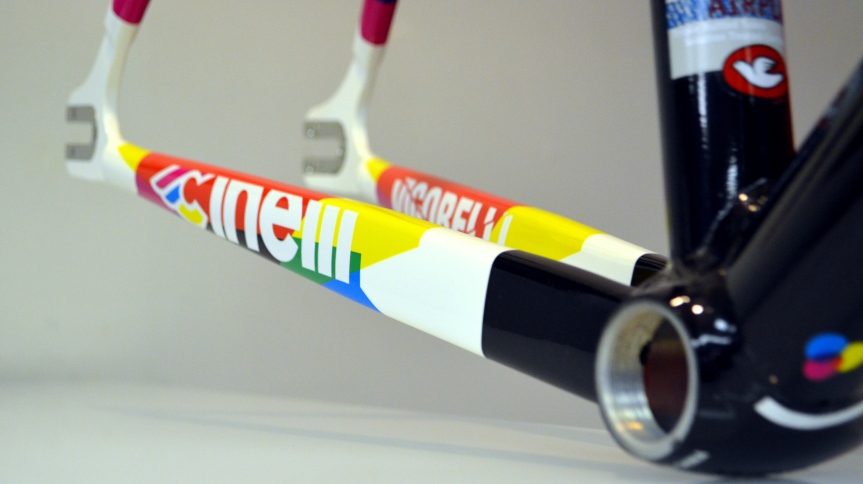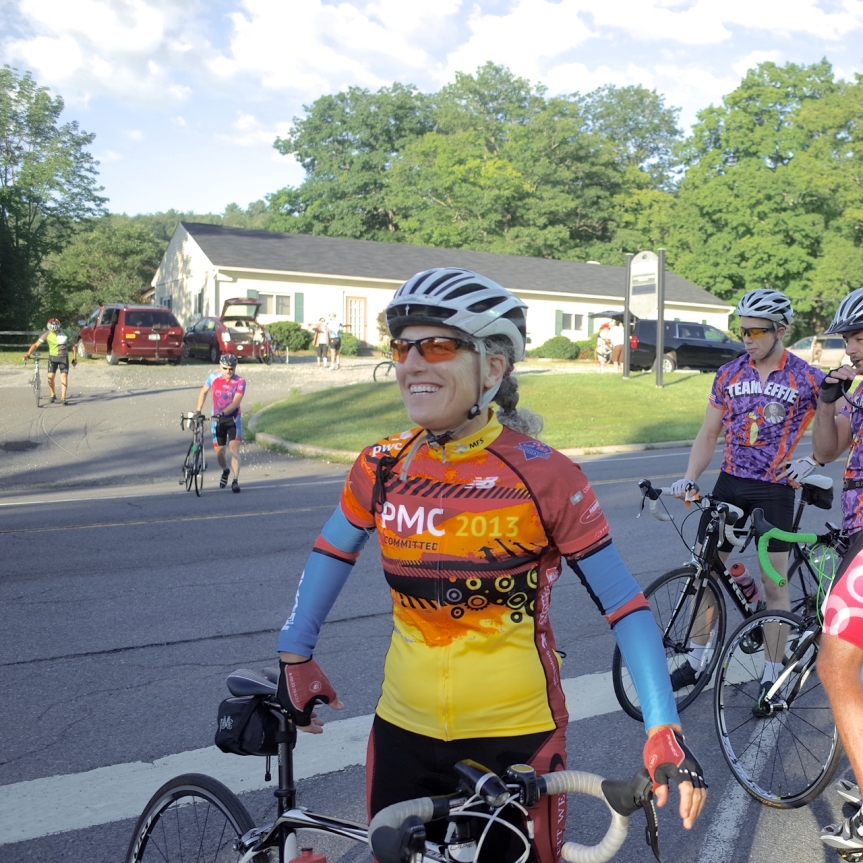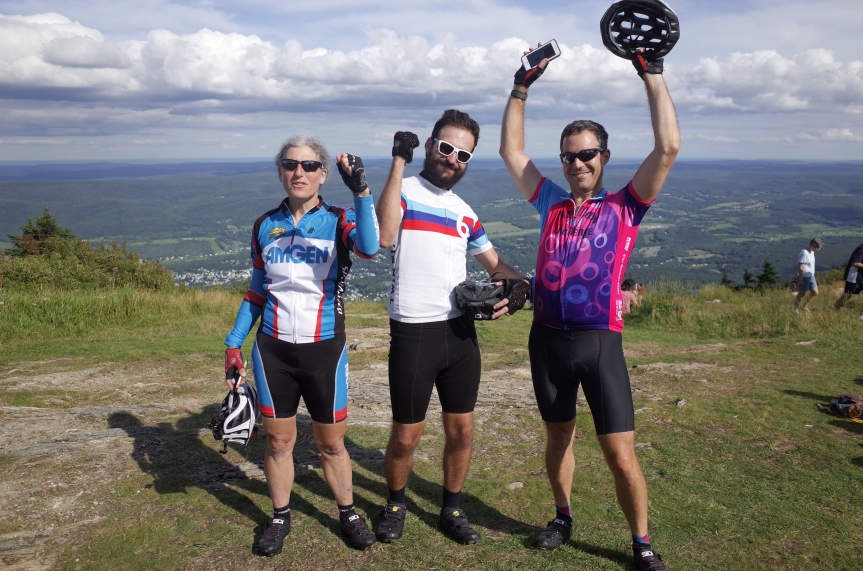Cycling is a sport, so let’s start playing fair.
As a cyclist, I’m distressed that equality for women is a conversation needing to be held in 2015. As a writer, the only logical choice I have is to use whatever voice this blog affords me to speak out against sexism.
Christina Julian, the marketing manager for Surly, published an article this week covering some reprehensibly sexist marketing themes at Interbike, and her numerous experiences of bias and inexcusable treatment by some members of the industry. You can read that article here: Our Own Two Wheels.
Jules puts the spotlight on two particularly egregious choices made this year at Interbike. The first was a pair of socks featuring scantily-clad women in the goodie-bag handouts to event attendees. The second was a marketing campaign by Chrome Industries featuring topless women handing out coupons in New York City. This type of sexualization in marketing in an industry which continually struggles, year over year, to expand the women’s cycling market highlights the backwards logic many still cling to in our sport.
I am beyond frustrated with these companies, but the presence of bias in the market is not an isolated issue. Some prevailing myths keeps the cycling industry from encouraging as many new female riders as it could be.
Myth #1: Professional Female Cyclists can’t be paid as much as their male counterparts.
Every sport has a women’s league, but rarely, if ever, do female athletes make as much as male athletes. Yet, in other high-profile sports, female athletes do manage to make a living, and support themselves to pursue their goals of international recognition and achievement. Not so in cycling, where payouts are significantly smaller for women than they are for men. Even top-level women’s races will often have a payout of just a few hundred dollars, when the men’s payouts at semi-professional races can be in the thousands.
This is an issue I’ve mostly witnessed in cyclocross races. With very little reward until the absolute highest levels of female cycling, the motivation to involve women in the sport is lacking. Women that do compete in Cat 1 and Cat 2 cycling races rarely, if ever, make the same living male cyclists can. It’s a barrier for entry when women need to consider the financial risk of traveling, competing, and losing.
A well-compensated, promoted, and supported women’s racing structure will have a significant effect on growing female involvement in the sport, both professionally and non-professionally. The Tour de France is a showcase of equipment with rippling effects on the massive bicycle market, and professional women’s racing will grow that market just as potently. Investing in race payouts will have a positive effect on cycling’s bottom line.
Physiology demands that men and women race in separate leagues (most of the time), but that doesn’t mean there needs to be a disparity in race payouts. The myth that women won’t bring in the same crowds for a sport based mostly in technical ability and strategy is self-perpetuating — unless we disrupt it. Ohio has already taken big strides in leveling the pay-outs between men’s and women’s cyclocross, with several Cincinnati races matching the winnings between genders. You can read more about these races from CX Magazine.
Myth #2. Women’s bikes and cycling gear need to be “pinkified,” or they won’t sell.
My aunt Linda has been cycling for decades, and I’ve never seen her wear pink. She rides a men’s road bike, a LaPierre in gold and black, and it suits her sensibilities perfectly. The trend in the cycling industry has been to decorate women’s versions of the top bicycles in ways that feel decidedly childish.
Yet, most female cyclists are not fifteen year olds with a penchant for princesses. They’re most often educated and mature adults, and when you start looking at bikes costing upwards of $3,000, the pastel color-ways and flower decals can limit sales, rather than grow them. If the industry had consulted women in the design process, a different design aesthetic would have made it to market.
Some women do appreciate these colorways, like framebuilder Julie Ann Pedalino and her (in?)famous pink RuPaul-inspired cyclocross bike, but there have always been multiple colors offered for men’s competition bikes for those who prefer a more subdued look. Girls deserve a choice, too, and that choice can grow the market.
Alessandra Cusatelli, the chief art director for Cinelli, is the artistic genius behind some of the most breathtaking frame art in the cycling industry. Her timeless and iconic designs are gender-nonspecific and universally celebrated. She and several other female designers are working to end the “pinkification” of women’s cycling gear and clothing, and you can check out their designs in this video from We Love Cycling. Other brands are starting to catch on, too.

Myth #3: There are no celebrities to follow in women’s cycling.
Most of my cycling heroes are women, and their names fall short of the celebrity of many male cyclists competing in the same events. There are inspiring and amazing women in cycling, yet a comparative lack of publicity and media coverage prevents them from reaching women who aren’t intimately involved in the sport already.
- Lael Wilcox- Lael is the current female record holder for the GDMBR, the Great Divide Mountain Bike Race. Lael peeled two full days off the previous record and broke the 2012 men’s record with an incredible 15 day, 10 hour, 59 minute time. If that wasn’t impressive enough, Lael set this time despite a hospital stay for severe bronchitis. She biked from Alaska to the starting line to compete, a distance of 2140 miles in 19 days. Check out more at Gypsy By Trade.
- Evelyn Stevens- Evelyn took 24th place in the 2012 Olympics as part of the US Women’s Olympic Team. Even more impressive: she made the team after only four years riding competitively on a bicycle. Evelyn worked in the corporate world in New York City, and picked up biking as a hobby in Central Park, and then trained up to Olympian athleticism from square one. Evie is proof that at the top levels of cycling, it comes down to pure will and mental fortitude.
- Ellen Noble- Ellen is this year’s Women’s Cyclocross Nationals champion, in a field stocked with seasoned professionals. Ellen has spoken out in big ways against the disparity between men’s and women’s cyclocross payouts. She also stops by Laughing Dog Bicycles once in a while, so I get to geek out over her Focus.
Myth #4: Women just aren’t interested in cycling the way men are.
Perhaps the most influential person for me in the world of cycling is a member of my own family.
Linda Epstein, my mom’s older sister, my aunt, and one of my close friends, is everything a cyclist of any gender should aspire to. We have a regular group for big rides like the Pan-Mass Challenge Zero Day, and Linda is far and above the strongest rider. There’s just no competition amongst the rest of us. We recently completed a 70-mile route with 8,800ft of climbing, and Linda’s pace up the final climb of Mt. Greylock was nothing short of awe-inspiring. Linda is used to being one of very few female cyclists in her riding group and skill level, but she consistently kicks everyone else’s butt without giving gender a second thought.
Linda rides for charity and has raised tens of thousands of dollars for the Pan-Mass Challenge. She’s a biochemist, and she leverages her position at Amgen (a cycling-friendly corporation if there ever was one) to raise money for good causes. She trains all year for the race and always rides her hardest. Linda encourages me to push my limits, and I would not be the cyclist I am today if it wasn’t for her mentorship and example. I am proud that Linda is one of many strong, educated, athletic, and barrier-breaking women in my family.
Max, The Cyclist will not often be a platform for anything. I do make exceptions, though, and gender inequality will always be a critical issue I will strive to push against. I introduced my girlfriend Kelley into the world of cycling, and her experience has been welcoming and encouraging thanks mostly to the people and companies I choose to associate with. Kelley’s experience is atypical, and that demands change.
I hope everyone who has read this far considers raising their own voice, until the manufacturers, organizers and would-be bigots are drowned out and this social topic becomes a history lesson in tomorrow’s textbooks.
Let’s work together and erase gender inequality in our sport.
P.S.
I am proud to ride a Surly, as they have shown to be an industry leader in tackling gender inequality. I am no longer associating myself with Chrome Industries, and I hope that others follow my example and shift away from brands that are willing to stoop to objectification of women to sell a product.




Female cycling elebrities? They don’t get better than Juliana Buhring http://julianabuhring.com/ . Ride on ladies!
I’m having similar thoughts in regards to the (*custom) electric (*cruiser) bicycle industry; Out of all the people who follow this page (*Electric cruiser bicycles on facebook) only 5% are women, does this mean that electric bikes don’t appeal to women, or that it’s the cycling industry in general which has an image problem, such as gender inequality? (for instance, photo-shoots to advertise Ebikes often use women as objects…)